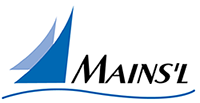SEXUAL AND OTHER UNLAWFUL HARASSMENT
Mains’l is committed to providing and maintaining a work environment free from all forms of discrimination and conduct that can be considered harassing, coercive, or disruptive, including sexual harassment and sexually offensive behaviors. It is the belief of Mains’l that all employees should be treated with dignity and respect and are entitled to work in an environment free from unsolicited and unwelcome sexual overtures, behaviors and other unwanted actions.
Mains’l does not tolerate sexually or other harassing or offensive behavior in the workplace, whether committed by supervisors, non-supervisory employees, or non-employees.
Sexual harassment is defined as unwanted sexual advances, or visual, verbal, or physical conduct of a sexual nature. This definition includes many forms of offensive behavior and includes gender-based harassment of a person of the same sex as the harasser. The following is a partial list of sexual harassment examples:
- Submitting to the conduct is made either explicitly or implicitly a term or condition of an individual’s employment;
- Submitting to or rejecting the conduct is used as the basis for an employment decision affecting an individual;
- Such conduct has the purpose or result of unreasonably interfering with an individual’s work performance; or
- Such conduct has the purpose or effect of creating an intimidating, hostile, or offensive working environment.
An intimidating, hostile, or offensive working environment is created by a wide range of sexually directed behaviors when they are unwanted, unwelcome, or personally offensive. In addition, if these behaviors interfere with the work performance of any or all employees, they are considered to be sexually harassing.
Examples, although not all inclusive, of sexually directed behaviors are:
- Offensive, sex oriented verbal kidding, jokes, innuendo, or abuse;
- Sexual flirtations, touching, advances, or propositions;
- Unwelcome and unwanted physical contact such as patting, pinching, or brushing against another’s body;
- Graphic or suggestive comments about an individual’s dress or body; sexually suggestive facial expressions; or
- The display in the work place of sexually suggestive objects or pictures.
Sexual harassment does not refer to occasional compliments or other generally acceptable social behavior.
Mains’l encourages employees to report all claims of sexual and other harassment immediately to their supervisor. If the supervisor is unavailable or an employee believes it would be inappropriate to contact that person, they should immediately contact human resources or any other member of management.
Mains’l Services does not retaliate or take any adverse action against any person who, in good faith, makes a claim of sexual harassment.
All allegations of sexual and other unlawful harassment are quickly and discreetly investigated. To the extent possible, employee’s confidentiality and that of any witnesses and the alleged harasser are protected against unnecessary disclosure. When the investigation is completed, the employee is informed of the outcome of the investigation. The investigation is comprised of the following steps:
- Confidentiality – Mains’l protects the confidentiality of employee claims to the best of its ability. At the same time, HR conducts a prompt and effective investigation. Therefore, it may not be possible to keep all information gathered in the initial complaint, such as interviews and records, completely confidential. All information gathered remains confidential to the extent possible for a thorough investigation. Some information is revealed to the accused and potential witnesses, but that information is shared only on a “need to know” basis.
- Interim Protection – Separation of the alleged victim from the accused may be necessary to guard against continued harassment or retaliation. A schedule change, transfer or leave of absence may be necessary. Mains’l works with the complainant to ensure that he or she feels safe during the duration of the investigation.
- Selection of the Investigator – HR staff have special training in conducting sexual harassment complaint investigations and are responsible for conducting investigations of these types.
- Creation of an Investigation Plan – A plan is constructed which includes an outline of the issue, the development of a witness list, sources for information and evidence, interview questions targeted to elicit crucial information and details, and a process for retention of documentation.
- Development of Interview Questions – Questions are developed during the planning stage, although additional questions may be added throughout the investigation as more evidence and information are shared.
- Interviews – The investigator informs all parties involved of the need for an investigation and explain the investigation process. Questions may be asked to relevant parties orally, and in some cases in writing.
- Decision – Once the investigation is complete, credibility is assessed and all information is evaluated. A final decision of any employment actions that are warranted are made at this time and all parties are informed of the decisions made.
Rev. 2/28/2019, HR Policy Team
- Printer-friendly version
- Log in to post comments
